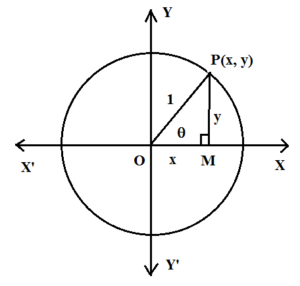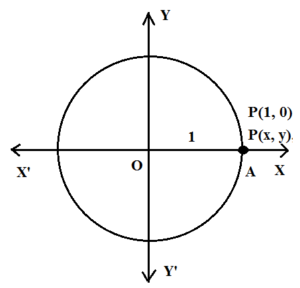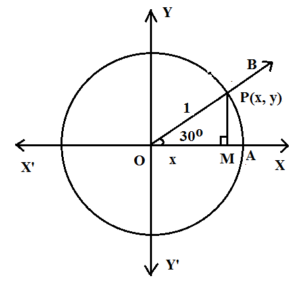In this article, we shall find values of trigonometric ratios of standard angles in the first and the second quadrants using a standard unit circle.
A circle with the centre at the origin and radius 1 is a standard unit circle. Let P(x, y) be any point on the unit circle with m∠ XOP = θ. Now P lies on the unit circle. Hence l(OP) = 1.

Let PM be perpendicular to OX. Thus ΔOMP is a right-angled triangle.
By Pythagoras theorem
OM2 + MP2 = OP2
x2 + y2 = 1
Then by definition of trigonometric ratios
sin θ = length of the opposite side / Length of the hypotenuse
sin θ = PM/ OP = y/1 = y
cos θ= length of the adjacent side / Length of the hypotenuse
cos θ= OM/ OP = x/1 = x
tan θ = length of opposite side / length of adjacent side
tan θ = PM/OM = y/x (x not equal to 0)
cosec θ = Length of hypotenuse / length of opposite side
cosec θ == OP/ PM = 1/y (y not equal to 0)
sec θ = Length of hypotenuse / length of adjacent side
sec θ = OP/ OM = 1/x (x not equal to 0)
cot θ = length of adjacent side / length of opposite side
cot θ = OM/PM = x/y (y not equal to 0)
From above values we can see that
cosec θ = 1/sin θ (if sin θ not equal to zero)
sec θ = 1/cos θ (if cos θ not equal to zero)
cot θ = 1/tan θ (if sin θ not equal to zero)
Notes:
- The trigonometric functions do not depend on the position of point P on the terminal ray but they depend on the measure of angle q.
- Coterminal angles have the same trigonometric functions
- Since x = cos θ and y = sinθ, point P has coordinates (cos θ, sin θ).
Let P(x, y) be on the standard unit circle such that
x2 + y2 = 1
x2 ≤ 1
– 1 ≤ x ≤ 1
– 1 ≤ cos θ ≤ 1
Similarly
y2 ≤ 1
– 1 ≤ y ≤ 1
– 1 ≤ sin θ ≤ 1
Similarly
sec θ ≥ 1 or sec θ ≤ – 1
cosec θ ≥ 1 or cosec θ ≤ – 1
tan θ and cot θ can be any real numbers.
Trigonometric Ratios of 0o or 0c:
Let us consider a standard unit circle

Let m∠ AOP = θ = 0o = 0c
Ray OA is the initial arm of the angle.
The terminal arm of the angle ray OP intersects the circle at P(1, 0)
Hence x = 1 an y = 0. Thus
sin 0o = y = 0
cos 0o = x = 1
tan 0o = y/x = 0/1 = 0
cosec 0o = 1/y (Not defined since y = 0)
sec 0o = 1/x = 1/1 = 1
cot 0o = x/y (Not defined since y = 0)
| sin 0o sin (0)c | cos 0o cos (0)c | tan 0o tan (0)c | cosec 0o cosec (0)c | sec 0o sec (0)c | cot 0o cot (0)c |
| 0 | 1 | 0 | – | 1 | – |
Trigonometric Ratios of 30o or (π/6)c:
Let us consider a standard unit circle

Let m∠ AOP = θ = 30o = (π/6)c
Ray OA is the initial arm of the angle.
The terminal arm of the angle ray OP intersects the circle at P(x, y)
Let PM be perpendicular to OX. Thus ΔOMP is 30o-60o-90o triangle
PM = 1/2(OP) = 1/2 (1) = 1/2 (side opposite to 30o)
OM = √3/2(OP) = √3/2 (1) = √3/2 (side opposite to 60o)
Point P is in the first quadrant
Hence x = √3/2 an y = 1/2. Thus
sin 30o = y = 1/2
cos 30o = x = √3/2
tan 30o = y/x = (1/2)/(√3/2) = 1/√3
cosec 30o = 1/y = 1/(1/2) = 2
sec 30o = 1/x = 1/(√3/2) = 2/√3
cot 30o = x/y = (√3/2)/(1/2) = √3
| sin 30o sin (π/6)c | cos 30o cos (π/6)c | tan 30o tan (π/6)c | cosec 30o cosec (π/6)c | sec 30o sec (π/6)c | cot 30o cot (π/6)c |
| 1/2 | √3/2 | 1/√3 | 2 | 2/√3 | √3 |
Trigonometric Ratios of 45o or (π/4)c:
Let us consider a standard unit circle

Let m∠ AOP = θ = 45o = (π/4)c
Ray OA is the initial arm of the angle.
The terminal arm of the angle ray OP intersects the circle at P(x, y)
Let PM be perpendicular to OX. Thus ΔOMP is 45o-45o-90o triangle
PM = 1/√2(OP) = 1/√2 (1) = 1/√2 (side opposite to 45o)
OM = 1/√2(OP) = 1/√2 (1) = 1/√2 (side opposite to 45o)
Point P is in the first quadrant
Hence x = 1/√2 an y = 1/√2. Thus
sin 45o = y = 1/√2
cos 45o = x = √1/√2
tan 45o = y/x = (1/√2)/(1/√2) = 1
cosec 45o = 1/y = 1/(1/√2) = √2
sec 45o = 1/x = 1/(1/√2) = √2
cot 45o = x/y = (1/√2)/(1/√2) = 1
| sin 45o sin (π/4)c | cos 45o cos (π/4)c | tan 45o tan (π/4)c | cosec 45o cosec (π/4)c | sec 45o sec (π/4)c | cot 45o cot (π/4)c |
| 1/√2 | 1/√2 | 1 | √2 | √2 | 1 |
Trigonometric Ratios of 60o or (π/3)c:
Let us consider a standard unit circle

Let m∠ AOP = θ = 60o = (π/3)c
Let PM be perpendicular to OX. Thus ΔOMP is 30o-60o-90o triangle
PM = √3/2(OP) = 1/2 (1) = √3/2 (side opposite to 60o)
OM = 1/2(OP) = √3/2 (1) = 1/2 (side opposite to 30o)
Point P is in the first quadrant
Hence x = 1/2 an y = √3/2. Thus
sin 60o = y = √3/2
cos 60o = x = 1/2
tan 60o = y/x = (√3/2)/(1/2) = √3
cosec 60o = 1/y = 1/(√3/2) = 2/√3
sec 60o = 1/x = 1/(1/2) = 2
cot 60o = x/y = (1/2)/(√3/2) = 1/√3
| sin 60o sin (π/3)c | cos 60o cos (π/3)c | tan 60o tan (π/3)c | cosec 60o cosec (π/3)c | sec 60o sec (π/3)c | cot 60o cot (π/3)c |
| √3/2 | 1/2 | √3 | 2/√3 | 2 | 1/√3 |
Trigonometric Ratios of 90o or (π/2)c:
Let us consider a standard unit circle

Let m∠ AOP = θ = 90o = (π/2)c
Let PM be perpendicular to OX. M coicides with O
PM = 1 and OM = 0
Point P is on postive y-axis
Hence x = 0 an y = 1. Thus
sin 90o = y = 1
cos 90o = x = 0
tan 90o = y/x (Not defined since x = 0)
cosec 90o = 1/y = 1/1 = 1
sec 90o = 1/x (Not defined since x = 0)
cot 90o = x/y = 0/1 = 0
| sin 90o sin (π/2)c | cos 90o cos (π/2)c | tan 90o tan (π/2)c | cosec 90o cosec (π/2)c | sec 90o sec (π/2)c | cot 90o cot (π/2)c |
| 1 | 0 | – | 1 | – | 0 |
Trigonometric Ratios of 120o or (2π/3)c:
Let us consider a standard unit circle

Let m∠ AOP = θ = 120o = (2π/3)c
m∠ POM = 60o
Let PM be perpendicular to OX’. Thus ΔOMP is 30o-60o-90o triangle
PM = √3/2(OP) = 1/2 (1) = √3/2 (side opposite to 60o)
OM = 1/2(OP) = √3/2 (1) = 1/2 (side opposite to 30o)
Point P is in the second quadrant
Hence x = – 1/2 an y = √3/2. Thus
sin 120o = y = √3/2
cos 120o = x = -1/2
tan 120o = y/x = (√3/2)/(-1/2) = -√3
cosec 120o = 1/y = 1/(√3/2) = 2/√3
sec 120o = 1/x = 1/(-1/2) = – 2
cot 120o = x/y = (-1/2)/(√3/2) = – 1/√3
| sin 120o sin (2π/3)c | cos 120o cos (2π/3)c | tan 120o tan (2π/3)c | cosec 120o cosec (2π/3)c | sec 120o sec (2π/3)c | cot 120o cot (2π/3)c |
| √3/2 | -1/2 | -√3 | 2/√3 | -2 | -1/√3 |
Trigonometric Ratios of 135o or (3π/4)c:
Let us consider a standard unit circle

Let m∠ AOP = θ = 135o = (3π/4)c
m∠ POM = 45o
Ray OA is the initial arm of the angle.
The terminal arm of the angle ray OP intersects the circle at P(x, y)
Let PM be perpendicular to OX’. Thus ΔOMP is 45o-45o-90o triangle
PM = 1/√2(OP) = 1/√2 (1) = 1/√2 (side opposite to 45o)
OM = 1/√2(OP) = 1/√2 (1) = √1/√2 (side opposite to 45o)
Point P is in the second quadrant
Hence x = – 1/√2 an y = 1/√2. Thus
sin 135o = y = 1/√2
cos 135o = x = – 1/√2
tan 135o = y/x = (-1/√2)/(1/√2) = – 1
cosec 135o = 1/y = 1/(1/√2) = √2
sec 135o = 1/x = 1/(-1/√2) = – √2
cot 135o = x/y = (-1/√2)/(1/√2) = – 1
| sin 135o sin (3π/4)c | cos 135o cos (3π/4)c | tan 135o tan (3π/4)c | cosec 135o cosec (3π/4)c | sec 135o sec (3π/4)c | cot 135o cot (3π/4)c |
| 1/√2 | – 1/√2 | – 1 | √2 | – √2 | – 1 |
Trigonometric Ratios of 150o or (5π/3)c:
Let us consider a standard unit circle

Let m∠ AOP = θ = 150o = (5π/6)c
m∠ POM = 30o
Ray OA is the initial arm of the angle.
The terminal arm of the angle ray OP intersects the circle at P(x, y)
Let PM be perpendicular to OX’. Thus ΔOMP is 30o-60o-90o triangle
PM = 1/2(OP) = 1/2 (1) = 1/2 (side opposite to 30o)
OM = √3/2(OP) = √3/2 (1) = √3/2 (side opposite to 60o)
Point P is in the second quadrant
Hence x = – √3/2 an y = 1/2. Thus
sin 150o = y = 1/2
cos 150o = x = – √3/2
tan 150o = y/x = (1/2)/(-√3/2) = – 1/√3
cosec 150o = 1/y = 1/(1/2) = 2
sec 150o = 1/x = 1/(-√3/2) = – 2/√3
cot 150o = x/y = (-√3/2)/(1/2) = – √3
| sin 150o sin (5π/6)c | cos 150o cos (5π/6)c | tan 150o tan (5π/6)c | cosec 150o cosec (5π/6)c | sec 150o sec (5π/6)c | cot 150o cot (5π/6)c |
| 1/2 | – √3/2 | – 1/√3 | 2 | – 2/√3 | – √3 |
Trigonometric Ratios of 180o or πc:
Let us consider a standard unit circle

Let m∠ AOP = θ = 180o = πc
Ray OA is the initial arm of the angle.
The terminal arm of the angle ray OP intersects the circle at P(-1, 0)
Hence x = -1 an y = 0. Thus
sin 180o = y = 0
cos 180o = x = – 1
tan 180o = y/x = 0/-1 = 0
cosec180o = 1/y (Not defined since y = 0)
sec 180o = 1/x = 1/-1 = – 1
cot 180o = x/y (Not defined since y = 0)
| sin 180o sin (π)c | cos 180o cos (π)c | tan 180o tan (π)c | cosec 180o cosec (π)c | sec 180o sec (π)c | cot 180o cot (π)c |
| 0 | – 1 | 0 | – | – 1 | – |